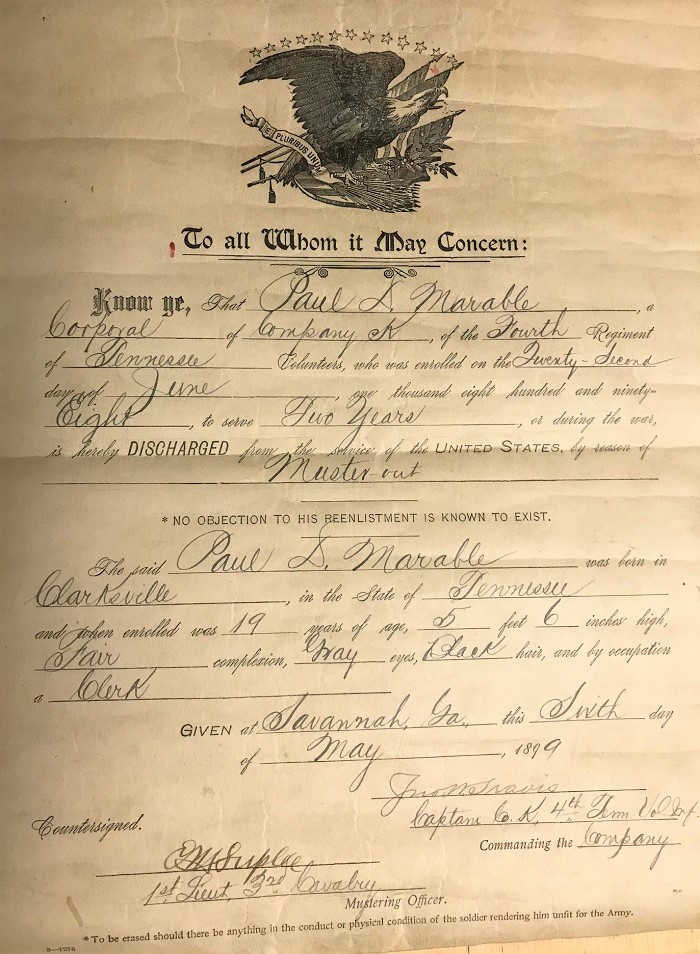
What is a Spanish American War Discharge
Document?
By Patrick McSherry
Is This Website Helpful?
Use the Button to Put a Tip in our Virtual Tip Jar!

Please Visit
our Home Page to learn more about the
Spanish American War
Contribute data to the Spanish
American War Veteran Gravesite Recording Project! Click
here to find out how!
Want to know how to
research a Spanish American War veteran, click
here to find out how!
General:
We often reference a soldier's military discharge record. What is the
military discharge? What does it look like? What kind of data does it
contain. This article will address the issues.
The example discharge shown below is that of
Paul D. Marable who served in Company
K of the 4th Tennessee Volunteer
Infantry. Mr. Marable was the great-grandson of John Hartwell
Marable, a congressman and friend of Andrew Jackson and Sam Houston.
Marable attending Southwestern Presbyterean University in Clarkesville.
After serving in the 4th Tennessee, he
joined the U.S. Army Corps of Engineers, and worked as a surveyor,
mapping portions of "Indian Territory" (present day Oklahoma). He also
served as a surveyor for the line of the Missouri Pacific Railroad. He
eventually returned to Tennessee, moving to Memphis. Later he
relocated to Chicago, Illinois where he served as the chief tariff
officer of the Illinois Central Railroad. He died on July 25, 1937 at
the age of 58. Marable was apparently also active in politics, and
served as campaign manager.
The Military Discharge:
Receiving the disharge document was an important event for the soldier.
This was his key to returning to civilian life. The goverment,
interestingly, seemed to have a sense of humor about this as can be see in
the text of the cardboard cylinder that was provided to contain the
document. Surviving discharges are not rare particularly, but are getting
more so as time goes on. However, the tube that was provided to house the
document was often discarded and is rare. An example of the tube that came
with the discharge shown at the bottom of this page is shown here:

The cardboard cylinder noted that the discharge was for a member
of a volunteer regiment, as opposed
to a member of the U.S. Regulars. It had the very welcome printed note
stating "Am I Going Home? Oh! Yes."

The oppposite side of the cardboard cyclinder read "Home, Sweet
Home." and noted the company and regiment
of the soldier being discharged.
The document itself provides several sets of information on the veteran,
based on records retained by the regiment in their "Regimental Discriptive
Book" or "Company Descriptive Book." These books contained the records on
each of the soldiers, and was updated as things changed. The upper portion
of the dicharge lists the soldier's name, his final rank (he may have
enlisted as a private but rose in rank...or vice versa) at the time of
mustering out, his company and regiment. The document will incude the date
that he enrolled in the regiment and what length of enlistment he agreed
to by joining this regiment. The document states the reason for the
soldier's discharge from the regiment. In this case it provides the most
common reason - the regiment was mustered out, or officially disbanded,
being no longer needed. Other reasons that may be listed include being
discharged by the order of the regimental surgeon, being discharged by
courtmartial (dishonorable discharge), etc.
The lower portion of the document provides a description of the soldier,
listing the town he stated was his place of residence at the time of
enlistment, his age, and a physical description consisting of height,
complexion, hair color and eye color. The soldier's occupation at the time
of his enlistment is also provided.
The location that the discharge document was issued is listed and one of
his commanding officers will have signed the document. Also listed is the
officer charged with mustering the regiment out. Usually this was an
officer of the regular army as opposed to an officer of a volunteer
regiment. The mustering officer has no association with the regiment, but
only serves to officially muster the soldier (or the entire regiment) out
of service.
Soldiers usually held on to this document as it was important when the
soldier attempted to obtain any benefits from the government. This
document provided all of the basic information he would need to complete
the required forms and was his proof of service.

Hammer, Sue - the discharge and container,
as well as data on Paul Marable.
"Paul D. Marable" Chattanooga
Daily Times. July 25, 1937, Page 7.
Dewey's
Flagship, OLYMPIA needs your help!! Click here
to learn how you can help!
Support
this
Site by Visiting the Website Store! (help
us defray costs!)
We are providing the following
service for our readers. If you are interested in books, videos, CD's
etc. related to the Spanish American War, simply type in "Spanish
American War" (or whatever you are interested in) as the keyword and
click on "go" to get a list of titles available through Amazon.com.
Visit Main Page for
copyright data
Return to Main Page
Return to Researching a Spanish
American War Veteran Page





